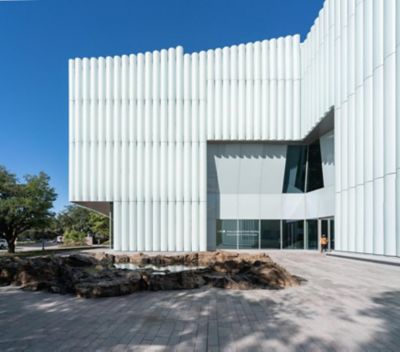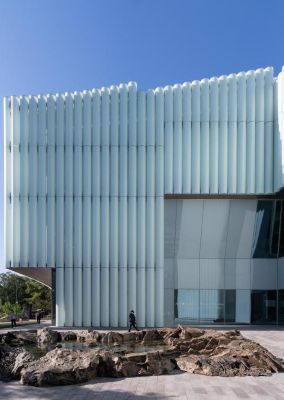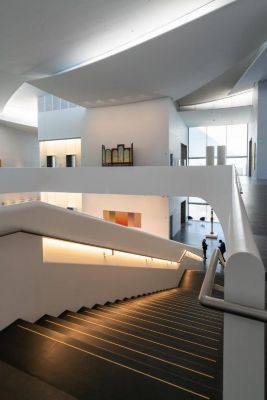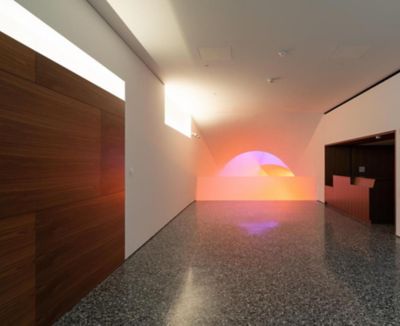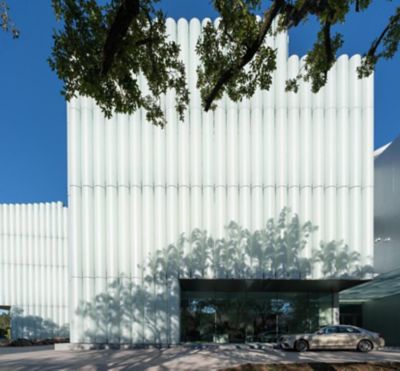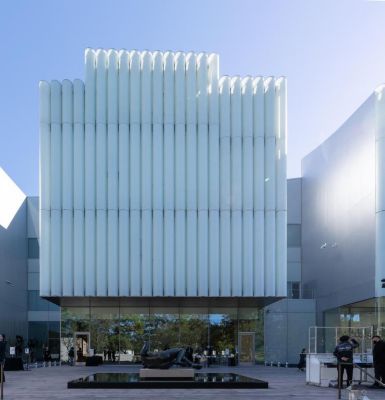Museum of Fine Arts Houston - Kinder Building
2020 Vanceva World of Color Awards - Exterior Category Winner
| Location | Houston, Texas, U.S.A |
| Completion date |
July 2020 |
| Architects |
Steven Holl Architects |
| Glass Laminator |
ShenZhen ShenNanYi Glass Product Co., Ltd |
| Featured products | 4 layers of Vanceva whites in 0009 |
| Photo credit | © Richard Barnes and Olaf Schmidt |
- Project description
- Related Products
- Tools
Natural light offers new perspective on fine art.
The new addition of the Museum of Fine Arts Houston (MFAH) boasts an unusual treasure – natural light. Daylight is dynamic and can change the brightness and color of art, making artificial lighting a frequent choice of museums. This is why cultural arts buildings tend to be devoid of glass walls and windows. But Stephen Holl Architects, who designed the new addition, had a distinctly different idea. Using an ingenious system of laminated, translucent glass tubes on the outside walls of the buildings, they found a way to control the light coming in, while protecting the priceless classical art inside. Punched openings in the weather wall are opaque and offer a different experience of light behind the glass tubes. Daylight also flows in from clerestory glazing, making the experience of visiting a naturally lit museum completely unique. At night, the glass tubes glow with a soft artificial light, creating a luminous streetscape.
The museum was extended by new two building complexes, now called the Kinder Building. With the placement of the museum in the heart of Houston's Museum District — surrounded by iconic buildings, including Mies van der Rohe's existing Museum building — the design had to be a showpiece.
Working collaboratively with Holl Architects and façade specialists Josef Gartner, German glass façade experts Knippers Helbig began work on creating the glass tubes. The design called for a "cool jacket facade" — a ventilated facade structure consisting of approximately 1,150 translucent glass tubes with a length of up to 6.50m. Almost the entire building is wrapped with translucent glass tubes, which are located in front of opaque walls and large punched windows. A steel substructure with an invisible structural glazing connection supports the tubes.
The glass tubes have an acid-etched surface on the outside with four translucent Vanceva Arctic Snow PVB interlayers, which precisely control the amount of daylight passing through them. The success of this project relied heavily on the meticulous selection of materials and forms, as well as through countless daylight simulations and mock-ups. During the Construction Documents Phase, a full-scale mockup was built to measure daylight transmission. Over several months, temperatures were measured on the tubes with the results used in detailed thermal and structural analysis.
The tight bending radius of the glass tubes meant that they could only be produced with gravitational bending. A series of tests were performed to ensure the load-bearing capacity of the glass. In addition to the architectural and daylight-control functions, the Vanceva PVB interlayers in the glass tubes also significantly contribute to the reduction of the energy transmission and the associated cooling loads. The PVB interlayers provide a high degree of safety. If a portion of the wall would be impacted, the glass would stay intact. “With translucent interlayers, the desired light transmission can be precisely fine-tuned to what was essential on this museum project,” according to Roman Schieber, Associate Director at Knippers Helbig, who led the glass façade portion project. “Unlike clear glass, translucent glass is visible and results in a totally different and fascinating perception of the space.”
Such a rare combination of natural light and fine art is already highly anticipated in the arts world. The Rich and Nancy Kinder Building opened in the fall of 2020.

Vanceva™ Colors
The Vanceva colors interlayer system enhances the style of laminated safety glass like never before—combining color and white interlayers to produce more than 69,000 transparent, translucent, or solid colored glass combinations - creating just the right look and ambience. In fact, no other PVB interlayer system offers the ability to achieve the range of colors and varied translucency in glass that Vanceva does.







